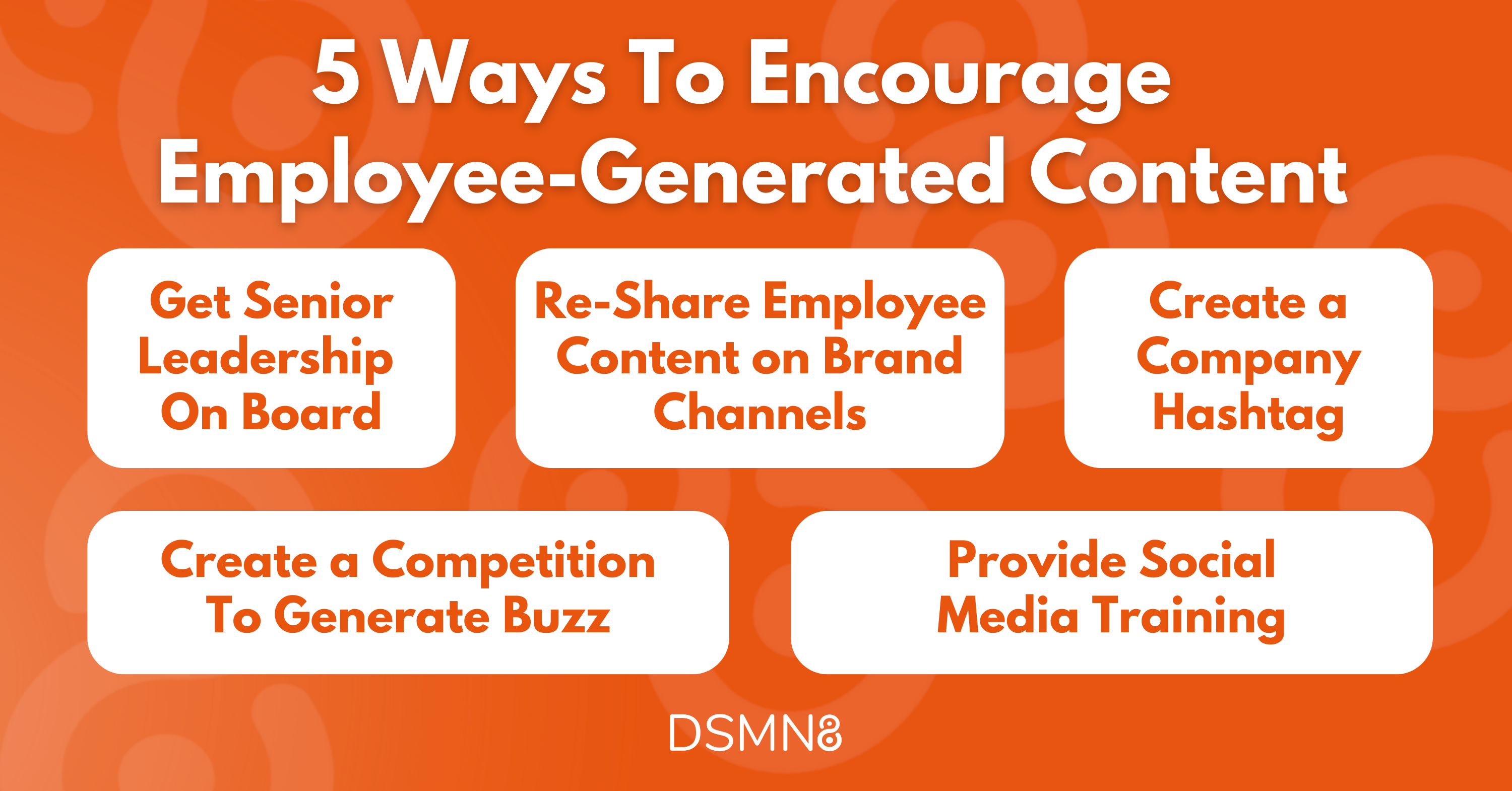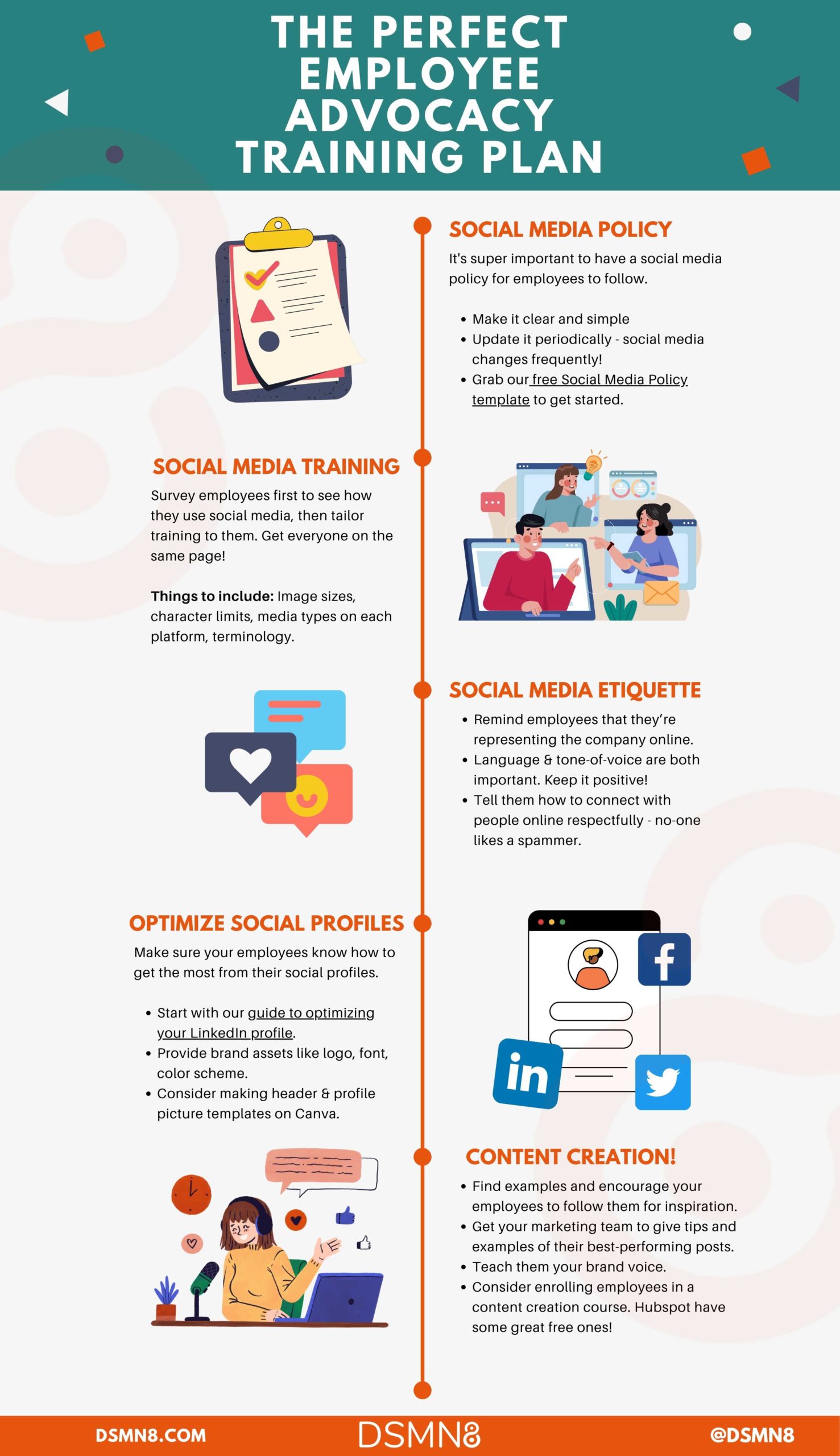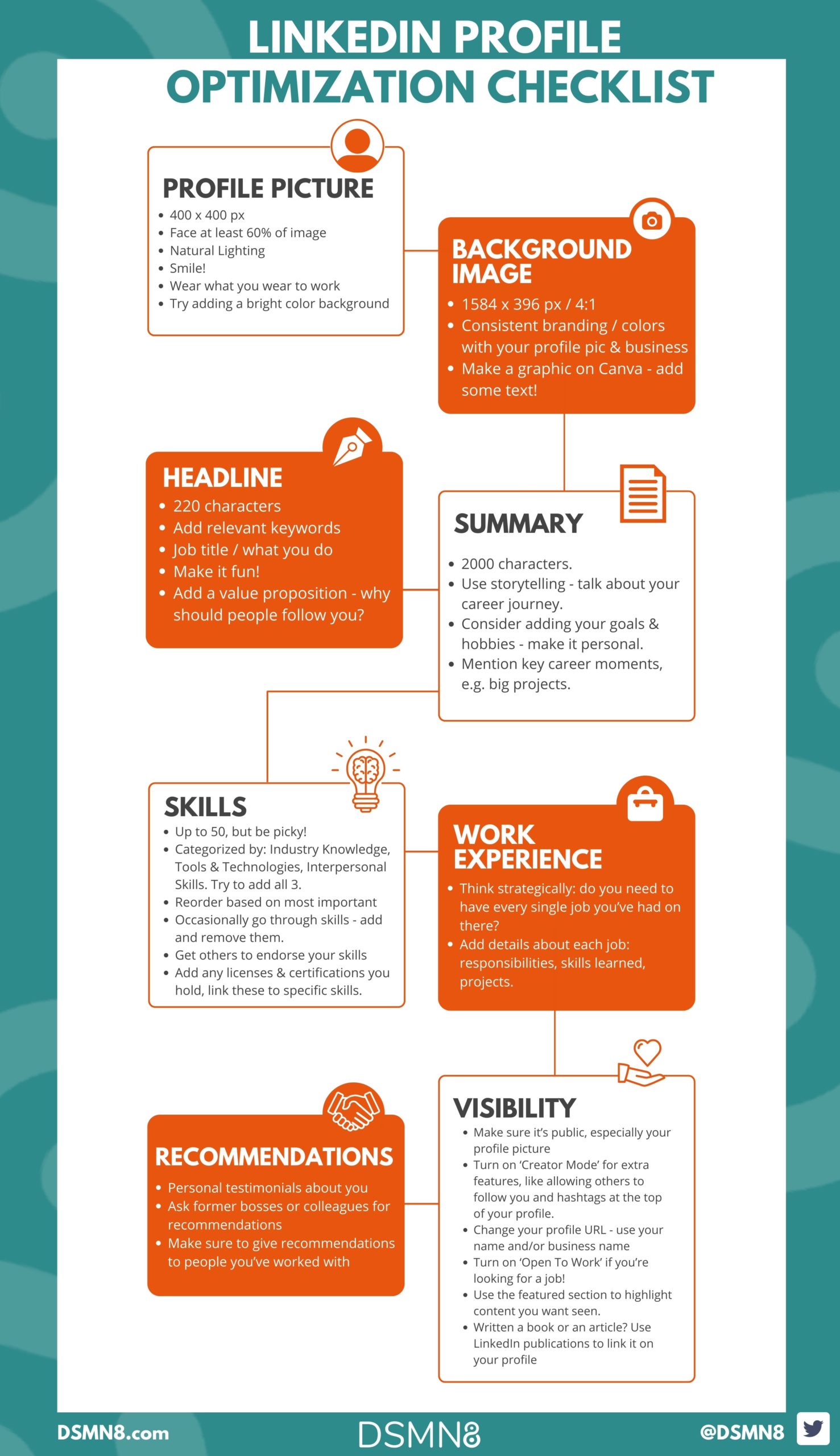
What's on this page?
- What is Employee-Generated Content?
- Why is Employee-Generated Content More Important Than Ever?
- Types of Employee-Generated Content
- 5 Ways To Encourage Employee-Generated Content
- Step-by-Step Guide to Ensuring Quality Employee-Generated Content
- How To Use Employee-Generated Content
- Additional Resources
Organizations wanting to grow their social media presence in 2023 need to focus on one key element: trust.
But how can brands build trust?
With authentic content.
It’s no secret that people trust people more than brands.
So more than ever, organizations are seeking authentic content created by those closest to the business: their employees.
But growing on social media isn’t the only benefit of employee-generated content. It also helps showcase your employer brand, attracting top talent.
Today, I’ll take you through how to encourage employee-generated content, and how to ensure that it’s high-quality, on-brand and legally compliant.
What Is Employee-Generated Content?
It’s exactly what is sounds like: content created by employees. Employee-generated content is a form of user-generated content (UGC), i.e. not created by a brand.
Typically, employee-generated content tends to focus on things like company culture and behind-the-scenes content, such as photos of team-building activities, awards, or events.
With the rise of social media influencer culture, many employees have built professional personal brands, particularly on LinkedIn.
Recently, ‘#WorkTok’ has been all the rage on TikTok, with young professionals creating videos about their job role, company, and industry. These ‘employee influencers’ are a huge asset to organizations, increasing brand awareness, building trust, and highlighting company perks like office meals or yoga classes.
On LinkedIn, content creators often share their expertise, industry news, and company announcements. Not only does this help the employee position themselves as a thought leader and build their professional network, but it provides huge value to the organization they work for too.
As the saying goes: people trust people. In fact, employee-generated content generates 800% more engagement than the exact same content posted by brand channels.
So whether your goal with EGC is to generate more qualified leads, or highlight your employer brand to reach the best candidates, encouraging employees to create and share content is the way to go.
Employee-generated content isn’t just social media posts. Don’t forget about things like Glassdoor reviews!
79% of candidates check Glassdoor before applying for a job.
Authentic reviews are one of the most valuable forms of employee-generated content, whether they come from current or previous team members. Genuine feedback from employees is always more impactful for attracting talent than company content alone.
Don’t be afraid to encourage employees to leave genuine reviews on Glassdoor, the impact is huge. Your marketing team can re-purpose these reviews for advertising too!
Why Is Employee-Generated Content More Important Than Ever for Businesses?
Since ‘The Great Resignation’ and the continuing impact of the COVID-19 pandemic, employers across many industries have found it more challenging than ever to attract top candidates.
Couple this with the rise in cost of living, and the increased prevalence of remote working, and it’s easy to see why employee retention has declined. Remote workers are often isolated from their colleagues, and don’t feel part of the company culture.
So, how can an organization wanting to recruit the best talent (and retain them) combat these issues?
Two words: Employer Branding.
Employer branding is all about showcasing company values and demonstrating why the organization is a great place to work. Putting a face (or many faces) to your brand and highlighting the employee experience makes all the difference in attracting top talent.
Studies have shown time and time again that content created by people gains much higher reach and engagement on social media than company profiles. Plus, they’re more likely to trust that content. A survey by AdWeek revealed that 76% of individuals are more likely to trust content from people over brands.
Your organization is filled with highly skilled individuals, so why not encourage them to demonstrate their expertise on social media?
Word-of-mouth recommendations are a time-tested way to generate interest in your product, brand, or job openings. Personally, I’d be much more likely to apply to work at a company that has been endorsed by someone in my network. I’m sure most people would agree.
Employee-Generated Content Types
There are many types of employee-generated content, it’s not all Instagram pictures of company parties! Here are some examples of EGC that your team are likely already creating.
- Photos of team events, awards, or company away days.
- Behind-the-scenes photos or videos showing a ‘Day in the Life’ of an employee.
- YouTube or TikTok videos talking about their career journey and offering advice to those early in their career.
- Writing blog posts sharing their thoughts on industry news.
- Third-party interviews about their job role or industry expertise.
- Talking about the perks of working at their company on social media.
- Celebrating a promotion or a work anniversary on LinkedIn.
- Writing a review on Glassdoor.
- Answering questions about your product/service on platforms like Reddit, Quora, or industry forums.
5 Ways to Encourage Employee-Generated Content
The good news is that when employees discover the benefits of advocacy for their careers, they’re more than willing to participate. And many are already creating content about their job or industry.
But to really get your employee-generated content initiative off the ground, here are 5 ways to encourage participation:

1. Create a Company Hashtag for Your Team to Use on Social Media
This could be something like #LifeAtCompanyName or #CompanyNameTeam.
2. Get Senior Leadership on Board
Employees are much more likely to participate if their manager or team leader is involved!
3. Create a Competition to Generate Some Initial Buzz
Offer a prize for the best behind-the-scenes photo, or for the most interesting take on recent industry news.
4. Ask Marketing to Provide Social Media Training Sessions
Ask marketing to provide social media training sessions, Cover bite-sized content creations tips like how to create a carousel post, or how to optimize a LinkedIn bio.
5. Reshare Employee Content on Your Brand Social Channels
This will help your employees reach a wider audience and show that you’re supporting them by spotlighting their insights.
Step-By-Step Guide to Ensuring Quality Employee-Generated Content
OK, so now you know what employee-generated content is, why it’s important for businesses, and how to encourage employees to create content.
But how can you ensure that the content is what you’re looking for?
I touched on training above, but let’s dive deeper 🤿
Step 1: Set Your Expectations
There’s simply no use expecting employees to create the kinds of content you want without setting expectations.
Unless they work in marketing or sales, most employees won’t have prior experience creating professional content.
In some ways, that’s a good thing! The last thing you want is your team sharing content filled with corporate jargon and marketing-speak. Authenticity is what you need.
That said, guidelines do need to be put in place.
Start off with updating your social media policy. It needs to emphasize that you encourage content creation, as well as highlighting the do’s and don’ts. Use DSMN8’s customizable social media policy template to get started.
Next, create a social media guidelines document, covering things like your brand style guide, tone-of-voice, and where employees can find support. If you’re unsure on this, I’ve put together a list of the 12 essential social media guidelines for all organizations with a downloadable PDF.
Step 2: Provide Training
Training really is essential.
You might think that all of your Millennial and Gen Z employees are social media pros, but social media for personal use is different to building a professional personal brand. Just ask any social media manager!
So, what training should your employees receive?
First, find out where they’re at. Every employees’ experience is different: some might already be micro-influencers, while others have never posted any content. Use this employee social media survey to find out.
Next, decide on the approach most suitable for your organization. If your workforce is largely remote, perhaps a video course would work best. Maybe several ‘lunch and learn’ sessions will suit your office-based team more. Getting your marketing team involved is ideal, as they know your brand identity best. But if they don’t have capacity, outsourcing to a professional training organization or agency may be the best solution.
Alternatively, if you’re implementing an employee advocacy program with software, speak to your platform provider about the training they provide. DSMN8’s customer success team are highly trained specialists who are more than happy to provide training for your advocates!
If you’re looking for a DIY approach, explore the advocacy training plan we put together.
Help Employees Understand the LinkedIn Algorithm
Rather than overwhelming your colleagues with best practices for every social media platform, focus your training on the channels you want employees to be active on.
Naturally, this will lean towards LinkedIn, as it is the main professional social media network.
Start by letting employees know how to optimize a LinkedIn profile for maximum visibility. Share this checklist with them:
Then show them the different types of content they can share on LinkedIn:
- Text-only posts
- Images & Videos
- Carousels
- Articles
Finally, rather than detailing the ins and outs of the LinkedIn algorithm, explain how they can create the kind of content favored by LinkedIn with the PACKD acronym. This will help avoid any unnecessary confusion!
So what does PACKD stand for? 📦
P = Perspective. Share your unique perspective on what you’re talking about. Don’t be afraid to have an opinion.
A = Advice. Use your expertise to offer advice. Remember to always add value in your content.
C = Core Subject Area. The content you’re sharing on LinkedIn should be part of your core subject area, e.g. your job role or industry.
K = Knowledge. If you want to become a thought leader, you need to be knowledgeable about the industry/topics you’re creating content about.
D = Distinct Audience. Think about who you’re speaking to. LinkedIn has explicitly said they don’t want ‘viral’ content, which tends to target a generalized audience. Focus on your niche.
Step 3: Leverage Technology
The best way to scale employee-generated content throughout your organization is to start an employee advocacy program.
For smaller organizations, this can be achieved manually, using your internal communications system to provide content for employees to share and add their insights to. Follow the process outlined above to encourage quality employee-generated content.
For larger advocacy programs, technology becomes an essential.
An employee advocacy platform like DSMN8 enables you to seamlessly distribute content for employees to share, while monitoring the impact, demonstrating ROI, and encouraging participation through competitive leaderboards and gamification.
In regulated industries like legal firms or pharmaceuticals, a key concern surrounding employee-generated content is legal compliance. The last thing you want is an employee going rogue and sharing confidential information.
There’s no easier way to mitigate this risk than by using DSMN8’s ISO-27001 certified employee advocacy software. The platform enables content admins to curate on-brand content, and provide pre-written post captions for your brand ambassadors to share.
How to Use Employee-Generated Content
Now you’ve got employees creating quality content, what should you do with it? 🤔
The biggest mistake many organizations make is encouraging EGC, then doing absolutely nothing with it.
Don’t let this content simply fall to the bottom of your social media feed and never see the light of day again 🤦🏻♀️
Save the images and screenshot the text-only posts for marketing and HR to use for employer branding campaigns! Don’t forget that you can use these images for advertising, whether online or offline, to showcase your company culture.
Engage with the content on your brand accounts, by leaving a comment or re-sharing employee posts. This helps get more eyes on the content, while showing employees that you appreciate their efforts!
Social media is the primary focus when it comes to employee advocacy and employer branding, but that doesn’t mean EGC can’t be used in other ways too.
Here are some ideas to get you started:
- Feature employee-generated content in your company newsletter, e.g. giving a monthly shoutout to an employee content creator.
- Has a member of your team taken some great photos that showcase your company culture? Use them in recruitment advertising campaigns.
- Print out photos by employees and create a photo wall or display in your office.
- Feature employee-generated content in your internal communications channel, whether that’s Slack, Teams, or an intranet website.
- Shout-out your top employee content creators in team calls/meetings!
Keep in mind that EGC isn’t just for external audiences to attract new talent and build trust – it’s also about fostering a positive company culture internally. Validating and recognizing your employee influencers is essential for ensuring consistent participation.
Additional Resources
Need some more help with encouraging employee-generated content?
Check out the podcast episode by DSMN8 CEO Bradley Keenan, covering his employee-generated content framework.
I also recommend listening to the Masterclass with Dropbox to learn how they built momentum over the first 30 days of their employee advocacy program.
Bradley is releasing a book in September, called Employee Advocacy: 101 Cheat Codes.
It covers over 100 actionable tips for launching, managing, and scaling your employee advocacy program.
We have a limited number of free physical copies of the book, so make sure to register your interest if you’d like one!
New To Employee Advocacy?
We’ve created a bunch of resources and templates to help get your employees more active on social media.
Whether you’re just launching an employee advocacy program, or you’ve been managing one for a while, you’ll find something helpful in our Resource Hub and Templates Gallery.
Here are some top picks:
Want to take employee advocacy to the next level?
We can help with that! 👋
Choose a time to speak with the team.
Prefer to jump straight in?
Book a Demo of DSMN8, the all-in-one Employee Advocacy Platform.
Emily Neal
SEO and Content Specialist at DSMN8. Emily has 10 years experience blogging, and is a pro at Pinterest Marketing, reaching 1 million monthly views. She’s all about empowering employees to grow their personal brands and become influencers.




